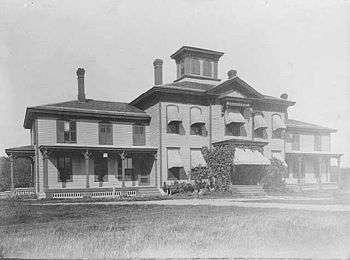William S. King
| William Smith King | |
|---|---|
 | |
| Member of the U.S. House of Representatives from Minnesota's 3rd district | |
|
In office March 4, 1875 – March 3, 1877 | |
| Preceded by | John T. Averill |
| Succeeded by | Jacob H. Stewart |
| Personal details | |
| Born | December 16, 1828 |
| Died | February 24, 1900 (aged 71) |
| Resting place | Lakewood Cemetery |
Colonel William Smith King (December 16, 1828 – February 24, 1900) was a Republican United States Representative for Minnesota from March 4, 1875 to March 3, 1877. He engaged in a variety of other activities, including journalism and surveying. King was born in Malone, New York in Franklin County where he grew up and attended the local schools and did agricultural work. In 1846, he moved to Otsego County, New York and worked as a solicitor for mutual insurance companies. He eventually became editor of the Free Democrat of Cooperstown, New York in 1852.
In 1858, King moved to Minneapolis, where he continued in journalism and agriculture. He founded the State Atlas newspaper in 1859. King became known for his strong editorials. Later, he helped create the Minneapolis Tribune, and became a major stockholder in the Pioneer Press in neighboring Saint Paul. There are also indications that he became a principal owner of the Minneapolis Journal.
King served as postmaster of the U.S. House of Representatives from 1861 to 1865 and 1867 to 1873. In 1874, he served as surveyor general of logs and lumber in the Third Congressional District of Minnesota. Following that, he served one term during the 44th congress.
In Minnesota, Colonel King also became involved in railroads and related pursuits. There are indications he was among the first people to lay streetcar rails in Minneapolis, perhaps as early as 1867. In 1877, he built a large pavilion at Lake Calhoun in the city. A tourism boom was occurring at the time. He later sold it to Louis F. Menage, who converted it to a hotel. However, the hotel was eventually destroyed by a fire.
During the 1870s, built his acclaimed 1,400 acres (5.7 km2) estate. Lyndale Farm reached south from 34th Street to Lake Harriet, allowing ample room to gather choice breeds of cattle for breeding purposes. His herd, including Shorthorn, Ayrshire, and Jersey, evolved into the best in the nation—to some, the world’s finest. King’s land, originally located in Richfield, was annexed to Minneapolis in 1867 by the state legislature.[1]
Upon his death in Minneapolis in 1900, his body was interred at Lakewood Cemetery.
It appears that the "Colonel" prefix is probably a nickname rather than an official military rank.
Glossary
- King's Fair: precursor to the Minnesota State Fair that was held in South Minneapolis from 1877 through 1882. Since 1979 the name has also been used for a biennial gathering in the Seward neighborhood. William S. King was a sponsor and organizer of the early fairs.[2]
- King Field: neighborhood in South Minneapolis named after William S. King, whose borders extend from Lyndale Avenue in the west to Interstate 35W in the east and from 36th Street in the north to 46th street in the south.[3]
- King's Highway: section of Dupont Avenue in South Minneapolis honoring William S. King.[4]
- King's Hill: popular sledding hill at Lyndale Farmstead Park.[5]
- Lyndale Avenue: Minneapolis street taking its name from Lyndale Farm, a 1,400-acre estate owned by William S. King.[6]
- Lyndale Farmstead Park: recreational area at 39th Street and Bryant Avenue South that was part of a vast farm belonging to William S. King and named for his father, Rev. Lyndon King.[3][5]
- Northrup-King Seed Company: prominent Minnesota business, whose founders included William S. King and his son Preston.[7]
- Oakwood Farm in Litchfield: Owned by William S. King and leased by W. H. Gibson.[8]
| United States House of Representatives | ||
|---|---|---|
| Preceded by John T. Averill |
Member of the U.S. House of Representatives from Minnesota's 3rd congressional district 1875–1877 |
Succeeded by Jacob H. Stewart |
References
- ↑ Johnson, Fred (2008) Richfield: Minnesota's Oldest Suburb, Richfield Historical Society
- ↑ King's Fair, Minneapolis placeography.org. Retrieved: February 11, 2013.
- 1 2 Kingfield, Minneapolis. placeography.org. Retrieved: February 11, 2013.
- ↑ Minneapolis Street Names. tholt.com. Retrieved: February 11, 2013.
- 1 2 Lyndale Farmstead Park. minneapolisparks.org. Retrieved: February 11, 2013.
- ↑ Neighborhood Names. johnweeks.com. Retrieved: February 11, 2013.
- ↑ Northrup, King and Company. mnopedia.org. Retrieved: February 11, 2013.
- ↑ David Rumsey Map Collection. davidrumsey.com. Retrieved: November 4, 2013.
- Russel L. Olson (1976). The Electric Railways of Minnesota. Minnesota Transportation Museum, Hopkins/H. M. Smyth Co., St. Paul.
- Lake Calhoun. WaterLaws.com. Accessed May 26, 2004.
External links

Minnesota Historical Society
Hennepin County Library
Placeography
Articles
- Northrup-King Seed Company at MNopedia.
- William S. King at Southwest Minneapolis Patch.
- Lyndale Farmstead Park at the Minneapolis Park and Recreation Board.
- United States Congress. "William S. King (id: K000218)". Biographical Directory of the United States Congress.
Louis F. Menage
- Erased from memory at the Twin Cities Daily Planet.
- The men behind the Metropolitan Building in the Star Tribune.